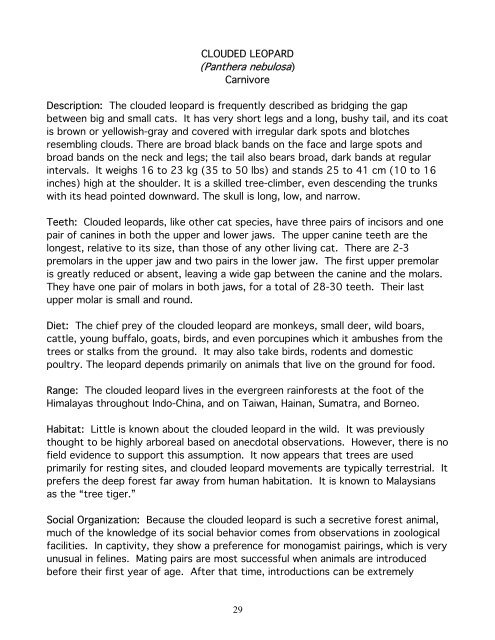TABLE OF CONTENTS - National Zoo
TABLE OF CONTENTS - National Zoo
TABLE OF CONTENTS - National Zoo
You also want an ePaper? Increase the reach of your titles
YUMPU automatically turns print PDFs into web optimized ePapers that Google loves.
CLOUDED LEOPARD<br />
(Panthera nebulosa)<br />
Carnivore<br />
Description: The clouded leopard is frequently described as bridging the gap<br />
between big and small cats. It has very short legs and a long, bushy tail, and its coat<br />
is brown or yellowish-gray and covered with irregular dark spots and blotches<br />
resembling clouds. There are broad black bands on the face and large spots and<br />
broad bands on the neck and legs; the tail also bears broad, dark bands at regular<br />
intervals. It weighs 16 to 23 kg (35 to 50 lbs) and stands 25 to 41 cm (10 to 16<br />
inches) high at the shoulder. It is a skilled tree-climber, even descending the trunks<br />
with its head pointed downward. The skull is long, low, and narrow.<br />
Teeth: Clouded leopards, like other cat species, have three pairs of incisors and one<br />
pair of canines in both the upper and lower jaws. The upper canine teeth are the<br />
longest, relative to its size, than those of any other living cat. There are 2-3<br />
premolars in the upper jaw and two pairs in the lower jaw. The first upper premolar<br />
is greatly reduced or absent, leaving a wide gap between the canine and the molars.<br />
They have one pair of molars in both jaws, for a total of 28-30 teeth. Their last<br />
upper molar is small and round.<br />
Diet: The chief prey of the clouded leopard are monkeys, small deer, wild boars,<br />
cattle, young buffalo, goats, birds, and even porcupines which it ambushes from the<br />
trees or stalks from the ground. It may also take birds, rodents and domestic<br />
poultry. The leopard depends primarily on animals that live on the ground for food.<br />
Range: The clouded leopard lives in the evergreen rainforests at the foot of the<br />
Himalayas throughout Indo-China, and on Taiwan, Hainan, Sumatra, and Borneo.<br />
Habitat: Little is known about the clouded leopard in the wild. It was previously<br />
thought to be highly arboreal based on anecdotal observations. However, there is no<br />
field evidence to support this assumption. It now appears that trees are used<br />
primarily for resting sites, and clouded leopard movements are typically terrestrial. It<br />
prefers the deep forest far away from human habitation. It is known to Malaysians<br />
as the “tree tiger.”<br />
Social Organization: Because the clouded leopard is such a secretive forest animal,<br />
much of the knowledge of its social behavior comes from observations in zoological<br />
facilities. In captivity, they show a preference for monogamist pairings, which is very<br />
unusual in felines. Mating pairs are most successful when animals are introduced<br />
before their first year of age. After that time, introductions can be extremely<br />
29
















